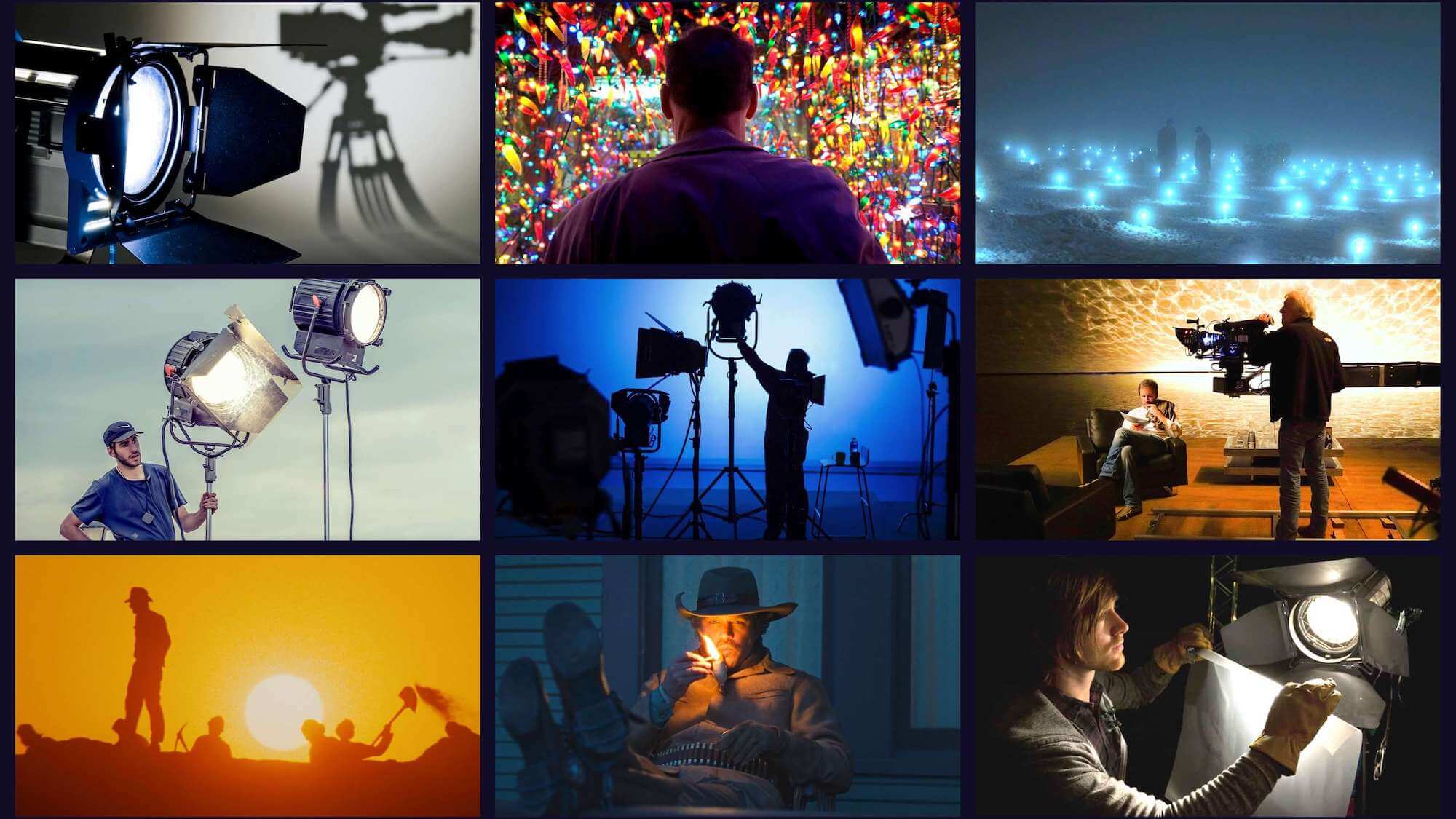Knowing how to film means knowing how to light. As a cinematographer, videographer, or director, you need to know an entire glossary of film lighting terms in order to effectively communicate your vision to the crew. We’ve listed the most common lighting terms you’ll hear on set.
Kinds of film lighting terms
Types of light
Lights come in countless shapes and sizes. As such, there are a plethora of film set lighting terms which refer to types of light.
Key Light – The primary source of illumination on a subject.
Fill Light – Softens and reduces shadows created by the key light.
Back Light – Placed behind the subject to separate them from the background.
Rim Light – A type of back light that creates a glowing outline around a subject.
Ambient Light – Natural or existing light already present in the scene.
Practical Light – Light sources that are visible within the scene.
Bounce Light – Light reflected off a surface to indirectly illuminate a subject.
Hard Light – Produces harsh shadows and sharp contrast.
Soft Light – Creates diffused shadows and an even spread of light.
Motivated Light – Artificial light that mimics a natural or practical source.
Natural Light – Light from the sun or moon.
Accent Light – A light which draws attention to a specific area in the frame.
Types of equipment lighting terms for film
Lighting equipment
On most sets, lighting requires a lot of gear, each with its own name and purpose. Here are a few you’ll likely come across:
Fresnel – A spotlight with a ridged lens, offering adjustable beam spread.
HMI – High-powered lights that typically mimic daylight.
LED Panel – Versatile, energy-efficient lighting with variable color temperatures.
Tungsten Light – Traditional film lighting with warm color temperature.
Kino Flo – Fluorescent lighting, often used for soft and even illumination.
China Ball – A spherical paper lantern that creates soft ambient lighting.
Barndoors – Metal flaps on lights to shape and direct the beam.
Diffusion Gel – Softens light; placed in front of light sources.
ND Gel – Reduces intensity of light without affecting color.
Flag – Opaque cloth used to block or shape light.
Scrim – A mesh that reduces light intensity without affecting its quality.
Bounce Board – White or reflective surface used to reflect light.
C-Stand – Short for Century Stand. Used to mount lights, flags, or other modifiers.
Gaffer Tape – Heavy-duty tape used to secure cables and equipment.
How to measure light
Lighting measurements
Lighting is a science as much as it is an artform. And as with any science, there are many kinds of measurements involved. Don’t skip this section if you’re a cinematographer.
Lux – Unit of luminance, measuring light intensity over a surface area.
Foot-Candle – U.S. equivalent to lux, used to measure brightness on set.
Color Temperature – Measured in Kelvin, refers to the warmth or coolness of light.
White Balance – Camera setting to balance color temperature of different lights.
Exposure – Amount of light reaching the camera sensor.
Contrast Ratio – Ratio between the lightest and darkest parts of the image.
Stops – Measurement of exposure; each stop doubles or halves light intensity.
False Color – Monitoring tool that maps brightness levels in different colors.
Technique film lighting terms
Lighting style
Ideally, your approach to lighting will result in a cohesive look that runs throughout your project. There are an infinite amount of ways to light a scene, and a wide selection of movie lighting terms to describe the look you’re going for.
High Key Lighting – Bright, low-contrast lighting.
Low Key Lighting – Dramatic, high-contrast lighting.
Chiaroscuro – Strong contrast between light and dark.
Rembrandt Lighting – Classic portrait lighting with a triangle of light on the cheek.
Split Lighting – Light illuminates only one side of the subject’s face.
Loop Lighting – Small shadow of the nose on the cheek, flattering and common.
Butterfly Lighting – Light directly above a subject’s face, creating a butterfly-shaped shadow.
Silhouette Lighting – Subject is backlit, rendering them as a dark shape.
Top Light – Light coming from directly above the subject.
Underlighting – Light from below a subject.
Cross Lighting – Two lights at opposite angles.
Cameo Lighting – Isolates a subject in light while the background fades to black.
Up Next
Basics of film lighting
Now you have a firm command over a wide array of film lighting terminology. It’s time to put them into practice. We lay out everything you need to know when you’re lighting a scene.
Film lighting overview →
Share your vision with elegant shot lists and storyboards.
Create robust and customizable shot lists. Upload images to make storyboards and slideshows.
